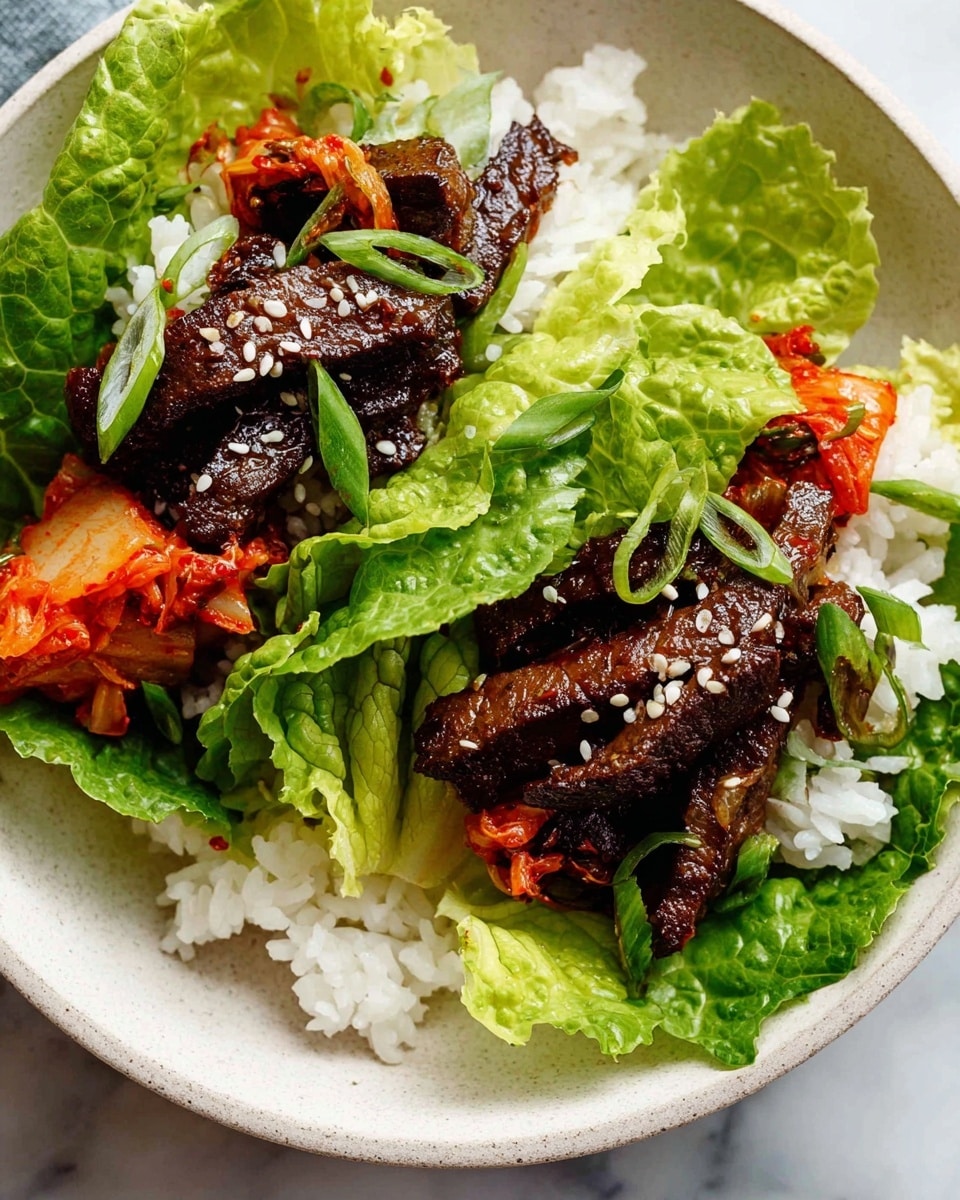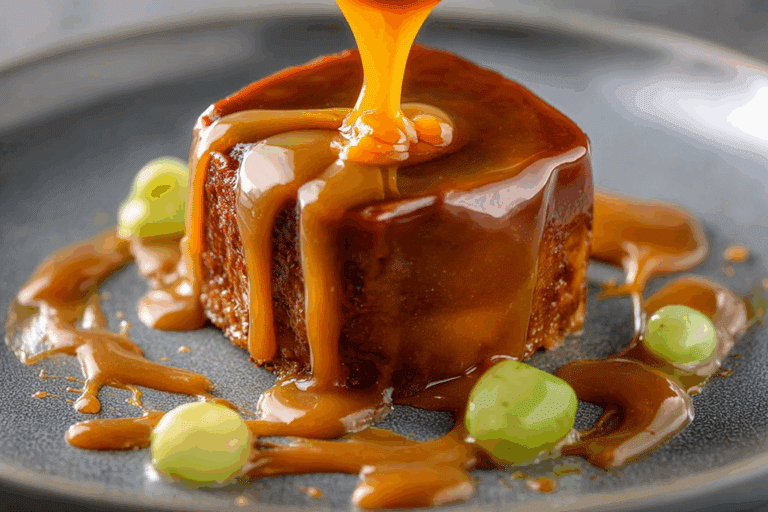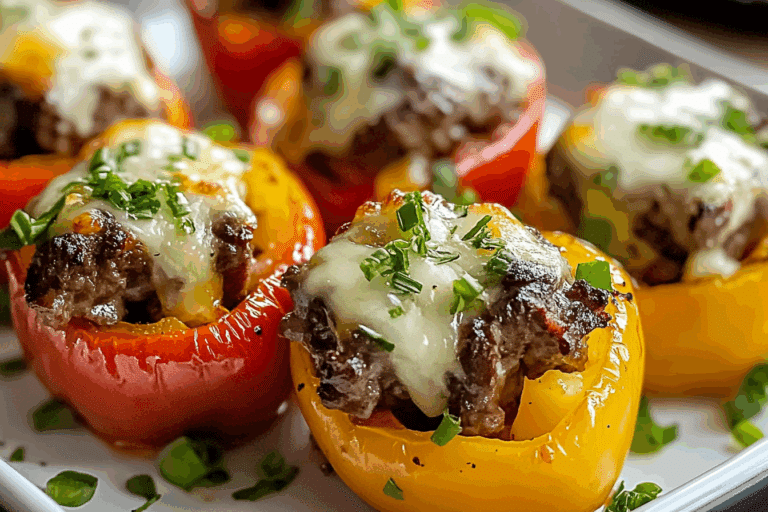Korean BBQ Beef (Bulgogi) Recipe
If you’re craving something that’s flavorful, a bit sweet, and downright irresistible, this Korean BBQ Beef (Bulgogi) recipe is going to be your new favorite go-to. I first tried bulgogi at a small Korean restaurant and immediately knew I had to figure out how to make it at home—because nothing beats that tender, marinated beef sizzling with just the right kick of sweetness and spice. Whether you’re cooking for a casual weeknight dinner or showing off your skills at a weekend gathering, this recipe delivers big on flavor without being complicated.
What makes this Korean BBQ Beef (Bulgogi) recipe so special is the marinade—it’s a perfect balance of soy sauce, honey, ginger, and the subtle heat of gochujang that works together to tenderize the beef and infuse it with layers of flavor. The best part? You don’t need a grill to enjoy that BBQ vibe. I usually cook it quickly in a pan on the stovetop, which locks in all those juicy, caramelized edges that make bulgogi addictive. Trust me, you’ll want to try this recipe again and again.
Ingredients You’ll Need
These ingredients come together beautifully, giving bulgogi its signature sweet-savory balance and tender texture. When you shop, aim for fresh, quality beef and real sesame oil—those little details make a huge difference in your final dish.
- Low-sodium soy sauce: Controls saltiness while providing that essential umami base in the marinade.
- White or yellow onion (grated): Adds natural sweetness and helps tenderize the beef.
- Honey or brown sugar: Brings caramelization and depth to the marinade.
- Gochujang: This Korean chili paste adds mild heat and complexity; if you’re new to it, start with a tablespoon and adjust to your taste.
- Minced garlic: For that punch of aroma and flavor.
- Grated fresh ginger: Brightens the dish with a bit of zing.
- Mirin: This sweet rice wine balances flavors and aids in caramelization.
- Toasted sesame oil: A little goes a long way to add nuttiness and fragrance.
- Cracked black pepper: Freshly cracked gives a nice bite.
- Boneless rib-eye or top sirloin (thinly sliced): Rib-eye is my personal favorite for its marbling and tenderness; ask your butcher to slice it thin, or freeze slightly to make slicing easier.
- Vegetable oil: For stir-frying the beef quickly without smoking.
- Optional (to serve): Rice, bibb lettuce for wrapping, kimchi, scallions, sesame seeds, ssamjang – all perfect accompaniments that bring the meal to life.
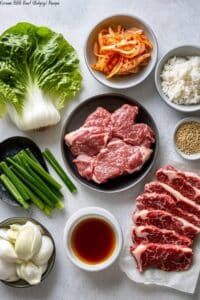
Variations
I love making this Korean BBQ Beef (Bulgogi) recipe my own depending on the occasion. Feel free to adjust the heat or switch up the sides—it’s all about what you enjoy most. Don’t hesitate to experiment!
- Spicier version: Adding extra gochujang or a dash of cayenne works wonders if you like a fiery kick; I’ve done this when serving friends who love some heat.
- Vegetarian twist: Swap the beef for shredded king oyster mushrooms marinated the same way—same flavor, different texture!
- Lower sugar: Swap honey for a sugar substitute or reduce it slightly for a less sweet marinade; I do this occasionally for weeknight meals.
- Grill instead of pan-fry: For authentic smoky flavor, try grilling the marinated beef over high heat.
- Meal prep style: Double the marinade and keep extra sliced beef in the freezer ready to go—such a lifesaver on busy days.
How to Make Korean BBQ Beef (Bulgogi) Recipe
Step 1: Prepare the Marinade
Start by grating the onion finely—that’s where a large-hole grater really shines, releasing all those juices that tenderize the meat and add sweetness. Then, mix it with soy sauce, honey, gochujang, minced garlic, fresh ginger, mirin, toasted sesame oil, and cracked black pepper in a bowl. I always taste a little bit of the marinade on its own before adding the beef to ensure the balance is just right—if it’s too sharp or salty, a splash of water or a pinch more honey usually fixes it.
Step 2: Slice and Marinate the Beef
Make sure your beef is sliced thinly—about an eighth to a quarter inch thick. If your butcher hasn’t done this for you, pop the beef in the freezer for about 30 minutes to firm it up; this makes slicing much easier and more precise. Once sliced, toss the beef with the marinade until every piece is coated, cover it, and let it sit in the fridge for at least 30 minutes—overnight if you want extra tender, flavorful meat. I usually marinate mine for about 2 hours when I plan ahead.
Step 3: Cook the Bulgogi
Heat a tablespoon of vegetable oil in a large skillet or wok over medium-high heat. When the pan is hot but not smoking, add the beef in a single layer—you may need to do this in batches to avoid overcrowding, which steams the meat instead of searing it. Cook for 2-3 minutes per side until the edges caramelize beautifully and the centers are just cooked through. You want that slightly crispy edge which adds amazing texture. Stir occasionally to prevent sticking, and if you notice too much liquid, increase the heat slightly to help it evaporate.
How to Serve Korean BBQ Beef (Bulgogi) Recipe
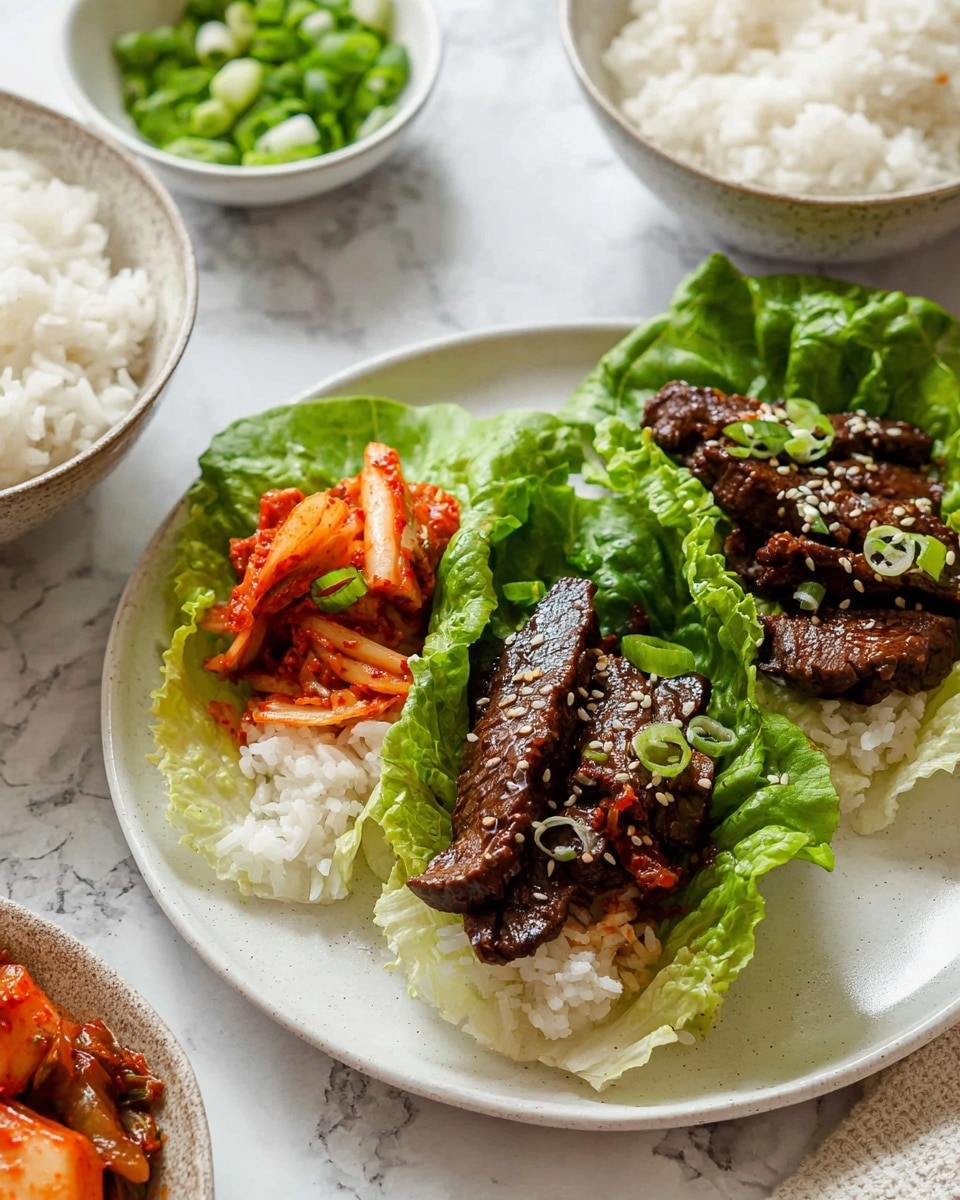
Garnishes
For me, green scallions and a sprinkle of toasted sesame seeds are the perfect garnishes—they add a fresh crunch and a little extra nuttiness that complements the rich beef. Plus, a small drizzle of extra sesame oil over the top just before serving takes it up a notch. I always have ssamjang on the side, which adds a spicy, savory dimension when you wrap the beef in lettuce.
Side Dishes
I almost always serve this Korean BBQ Beef (Bulgogi) recipe with steamed white rice and an assortment of kimchi and pickled veggies. It’s such a classic combo—the rice balances the bold marinade, and the kimchi adds that fermented crunch that’s downright addictive. Sometimes I throw in a simple spinach salad dressed with soy-sesame dressing to add freshness to the plate.
Creative Ways to Present
One of my favorite ways to present bulgogi for a party is as a “Korean lettuce wrap station”—lay out bibb lettuce leaves, bowls of sliced scallions, sesame seeds, ssamjang, and thinly sliced red chilies so guests can build their own wraps. It’s fun, interactive, and makes the meal feel special without extra fuss. I’ve also layered bulgogi over rice bowls with a fried egg on top for an easy, comforting meal.
Make Ahead and Storage
Storing Leftovers
I keep leftover Korean BBQ Beef in an airtight container in the fridge for up to 3 days. It still tastes delicious, though the texture softens a bit. I like to save it for quick lunches over rice or tossed into a stir-fry with fresh veggies.
Freezing
If you want to freeze it, I recommend freezing the marinated beef raw before cooking. Portion it into freezer bags to make weekday dinners a breeze. When you defrost later, just cook it the same way—it keeps the meat much fresher than freezing cooked bulgogi in my experience.
Reheating
To reheat leftovers, I find a quick stir-fry in a hot pan revives the beef best, restoring some of that nice caramelized texture. Avoid microwaving if you can, as it tends to make the meat rubbery. Adding a splash of water or a little extra sesame oil during reheating can keep things moist and tasty.
FAQs
-
Can I use other cuts of beef for Korean BBQ Beef (Bulgogi) recipe?
Absolutely! While rib-eye or top sirloin are ideal because they’re tender and flavorful, you can also use flank steak or sirloin tips. Just make sure to slice thinly against the grain for the best tenderness.
-
What if I don’t have gochujang?
If you can’t find gochujang, you can substitute with a mix of chili powder and a bit of miso paste, or even a mild chili garlic sauce. Keep in mind that gochujang brings a sweet-spicy depth that’s unique, so the flavor will be slightly different but still delicious!
-
How long should I marinate the beef?
For best results, marinate the beef for at least 30 minutes, but ideally 2 hours or overnight if you have time. The longer it marinates, the more tender and flavorful the beef becomes.
-
Can I grill the bulgogi instead of pan-frying?
Yes! Grilling bulgogi is fantastic and imparts a smoky char that’s hard to beat. Just be sure to use thin slices and watch carefully to avoid overcooking.
Final Thoughts
This Korean BBQ Beef (Bulgogi) recipe holds a special place in my kitchen repertoire because it’s simple yet delivers complex flavors that everyone loves. It feels like a little celebration every time I make it, whether it’s a laid-back dinner for two or a vibrant meal with friends. I can’t wait for you to try it—you’ll enjoy the perfect balance of sweet, savory, and spicy that keeps you coming back for more. Plus, once you master this, your kitchen is basically a Korean BBQ joint!
Print
Korean BBQ Beef (Bulgogi) Recipe
- Prep Time: 15 minutes
- Cook Time: 10 minutes
- Total Time: 25 minutes
- Yield: 4 servings 1x
- Category: Main Course
- Method: Frying
- Cuisine: Korean
Description
This Korean BBQ Beef Bulgogi recipe features thinly sliced marinated rib-eye or sirloin grilled to perfection. The marinade combines savory soy sauce, sweet honey, spicy gochujang, fragrant garlic and ginger, and toasted sesame oil, creating an irresistible balance of flavors. Often served with rice, lettuce wraps, kimchi, scallions, and sesame seeds, this dish is a classic Korean favorite that’s both quick and delicious.
Ingredients
Marinade Ingredients
- ¼ cup low-sodium soy sauce
- ½ large white or yellow onion, grated on a large-hole grater
- 3 tablespoons honey or brown sugar
- 1 tablespoon gochujang (Korean chili paste)
- 1 tablespoon minced garlic
- 1 tablespoon grated fresh ginger
- 1 tablespoon mirin (sweet rice wine)
- 1 tablespoon toasted sesame oil
- ¼ teaspoon cracked black pepper
Main Ingredient
- 1 pound boneless rib-eye or top sirloin, thinly sliced (⅛–¼ inch thick)
For Cooking
- Vegetable oil, for cooking
Optional Serving Ingredients
- Steamed rice
- Bibb lettuce leaves
- Kimchi
- Scallions, sliced
- Sesame seeds
- Ssamjang (Korean dipping sauce)
Instructions
- Prepare the Marinade: In a bowl, combine the low-sodium soy sauce, grated onion, honey or brown sugar, gochujang, minced garlic, grated ginger, mirin, toasted sesame oil, and cracked black pepper. Stir thoroughly until the honey or sugar is fully dissolved and the marinade is well blended.
- Slice the Beef: Cut 1 pound of boneless rib-eye or top sirloin into thin slices about ⅛ to ¼ inch thick. This ensures quick and even cooking and allows the marinade to penetrate well.
- Marinate the Beef: Place the sliced beef into the marinade, ensuring each piece is well coated. Let it marinate for at least 30 minutes at room temperature, or preferably up to 2 hours in the refrigerator for deeper flavor infusion.
- Heat the Pan: Add a small amount of vegetable oil to a large skillet or frying pan over medium-high heat. Allow the oil to become hot but not smoking to achieve a good sear on the beef.
- Cook the Beef: Add the marinated beef slices in a single layer without overcrowding the pan. Cook for 2 to 3 minutes on each side until the beef is browned and cooked through, stirring occasionally for even cooking.
- Serve: Remove the beef from heat and serve hot with steamed rice, bibb lettuce leaves for wrapping, kimchi, sliced scallions, sesame seeds, and ssamjang as accompanying condiments to enjoy the full Korean BBQ experience.
Notes
- For best results, slice the beef while it is partially frozen to achieve thin, even pieces.
- If gochujang is not available, substitute with a mix of chili flakes and a touch of miso paste for a similar flavor profile.
- Marinate the beef longer for more flavorful and tender results, but do not exceed 24 hours as the acid in the marinade can break down the meat excessively.
- Use a cast-iron skillet if possible for better heat retention and caramelization.
- Leftovers can be stored in an airtight container in the refrigerator for up to 3 days and reheated gently on the stovetop.
Keywords: Korean BBQ, Bulgogi, Korean beef, marinated beef, Korean barbecue recipe, quick Korean dinner

